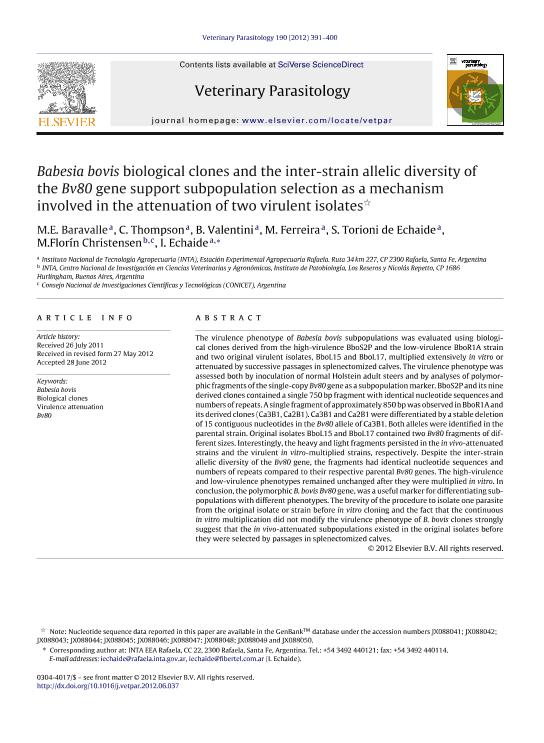Mostrar el registro sencillo del ítem
dc.contributor.author
Baravalle, María Eugenia

dc.contributor.author
Thompson, Carolina Soledad

dc.contributor.author
Valentini, B.
dc.contributor.author
Ferreira, M.
dc.contributor.author
Torioni de Echaide, Susana Marta

dc.contributor.author
Christensen, M. Florín
dc.contributor.author
Echaide, Ignacio Eduardo

dc.date.available
2023-05-09T13:17:55Z
dc.date.issued
2012-06
dc.identifier.citation
Baravalle, María Eugenia; Thompson, Carolina Soledad; Valentini, B.; Ferreira, M.; Torioni de Echaide, Susana Marta; et al.; Babesia bovis biological clones and the inter-strain allelic diversity of the Bv80 gene support subpopulation selection as a mechanism involved in the attenuation of two virulent isolates; Elsevier Science; Veterinary Parasitology; 190; 3-4; 6-2012; 391-400
dc.identifier.issn
0304-4017
dc.identifier.uri
http://hdl.handle.net/11336/196772
dc.description.abstract
The virulence phenotype of Babesia bovis subpopulations was evaluated using biological clones derived from the high-virulence BboS2P and the low-virulence BboR1A strain and two original virulent isolates, BboL15 and BboL17, multiplied extensively in vitro or attenuated by successive passages in splenectomized calves. The virulence phenotype was assessed both by inoculation of normal Holstein adult steers and by analyses of polymorphic fragments of the single-copy Bv80 gene as a subpopulation marker. BboS2P and its nine derived clones contained a single 750 bp fragment with identical nucleotide sequences and numbers of repeats. A single fragment of approximately 850 bp was observed in BboR1A and its derived clones (Ca3B1, Ca2B1). Ca3B1 and Ca2B1 were differentiated by a stable deletion of 15 contiguous nucleotides in the Bv80 allele of Ca3B1. Both alleles were identified in the parental strain. Original isolates BboL15 and BboL17 contained two Bv80 fragments of different sizes. Interestingly, the heavy and light fragments persisted in the in vivo-attenuated strains and the virulent in vitro-multiplied strains, respectively. Despite the inter-strain allelic diversity of the Bv80 gene, the fragments had identical nucleotide sequences and numbers of repeats compared to their respective parental Bv80 genes. The high-virulence and low-virulence phenotypes remained unchanged after they were multiplied in vitro. In conclusion, the polymorphic B. bovis Bv80 gene, was a useful marker for differentiating subpopulations with different phenotypes. The brevity of the procedure to isolate one parasite from the original isolate or strain before in vitro cloning and the fact that the continuous in vitro multiplication did not modify the virulence phenotype of B. bovis clones strongly suggest that the in vivo-attenuated subpopulations existed in the original isolates before they were selected by passages in splenectomized calves.
dc.format
application/pdf
dc.language.iso
eng
dc.publisher
Elsevier Science

dc.rights
info:eu-repo/semantics/openAccess
dc.rights.uri
https://creativecommons.org/licenses/by-nc-sa/2.5/ar/
dc.subject
BABESIA BOVIS
dc.subject
BIOLOGICAL CLONES
dc.subject
BV80
dc.subject
VIRULENCE ATTENUATION
dc.subject.classification
Otras Ciencias Veterinarias

dc.subject.classification
Ciencias Veterinarias

dc.subject.classification
CIENCIAS AGRÍCOLAS

dc.title
Babesia bovis biological clones and the inter-strain allelic diversity of the Bv80 gene support subpopulation selection as a mechanism involved in the attenuation of two virulent isolates
dc.type
info:eu-repo/semantics/article
dc.type
info:ar-repo/semantics/artículo
dc.type
info:eu-repo/semantics/publishedVersion
dc.date.updated
2023-05-05T17:18:43Z
dc.journal.volume
190
dc.journal.number
3-4
dc.journal.pagination
391-400
dc.journal.pais
Países Bajos

dc.journal.ciudad
Amsterdam
dc.description.fil
Fil: Baravalle, María Eugenia. Instituto Nacional de Tecnología Agropecuaria. Centro Regional Santa Fe. Estación Experimental Agropecuaria Rafaela; Argentina. Consejo Nacional de Investigaciones Científicas y Técnicas; Argentina
dc.description.fil
Fil: Thompson, Carolina Soledad. Instituto Nacional de Tecnología Agropecuaria. Centro Regional Santa Fe. Estación Experimental Agropecuaria Rafaela; Argentina
dc.description.fil
Fil: Valentini, B.. Instituto Nacional de Tecnología Agropecuaria. Centro Regional Santa Fe. Estación Experimental Agropecuaria Rafaela; Argentina
dc.description.fil
Fil: Ferreira, M.. Instituto Nacional de Tecnología Agropecuaria. Centro Regional Santa Fe. Estación Experimental Agropecuaria Rafaela; Argentina
dc.description.fil
Fil: Torioni de Echaide, Susana Marta. Instituto Nacional de Tecnología Agropecuaria. Centro Regional Santa Fe. Estación Experimental Agropecuaria Rafaela; Argentina
dc.description.fil
Fil: Christensen, M. Florín. Instituto Nacional de Tecnología Agropecuaria. Centro de Investigación en Ciencias Veterinarias y Agronómicas; Argentina
dc.description.fil
Fil: Echaide, Ignacio Eduardo. Instituto Nacional de Tecnología Agropecuaria. Centro Regional Santa Fe. Estación Experimental Agropecuaria Rafaela; Argentina. Consejo Nacional de Investigaciones Científicas y Técnicas; Argentina
dc.journal.title
Veterinary Parasitology

dc.relation.alternativeid
info:eu-repo/semantics/altIdentifier/doi/http://dx.doi.org/10.1016/j.vetpar.2012.06.037
Archivos asociados
